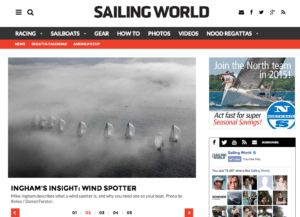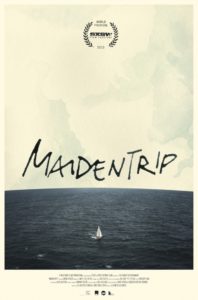
HWScandone368
Amidst the small fleet of BMWs, Porsches, and other late-model luxury autos gracing the parking lot of Southern California’s Balboa Yacht Club, Nick Scandone rolled in on his own special set of wheels and was asked how the day was going. He shifted hard in his seat–a throne from which he would not rise–and flashed a bright smile.
“Doing a lot better now that I’m down here,” he said. It was easy to understand why. Scandone may have arrived in a wheelchair, not a Lexus, but his day’s objective was precisely the same as the other club members: He was going sailing.
Other than the fact that he has a progressive neurodegenerative disease called ALS, or Lou Gehrig’s disease, which has begun the slow, irreversible process of ravaging his body, in figurative terms Scandone stands apart from his yacht-club peers in several aspects. For instance, he’s a much better sailor than almost all of them.
Scandone was diagnosed with ALS in 2002, and since then, he has risen steadily up the disabled sailing ranks, winning the 2.4 Meter Open World Championship in 2005 and, not coincidentally, earning the Rolex Yachtsman of the Year award the same year. And he didn’t stop there, for with his sailing partner, Maureen McKinnon-Tucker, Scandone will represent the United States at the Paralympic Games in China this September. When I met him on a sunny spring morning last April, he was getting ready for a day of training aboard his SKUD 18, the class in which he’ll compete at the Paralympics.
“Some people laugh when I say this, but the SKUD is lounge-chair sailing at its best,” said Scandone of the “lead-assisted” skiff he’s learning to master. “You’re basically sitting in a chair face forward. There’s no hiking. A lever switch tilts the seat back and forth when you tack. If it had a cooler and a couple of drink holders, it’d be a great afternoon cruiser for a lot of people. I think they’d really enjoy it.”
So there’s another thing about Scandone. ALS may have robbed him of his mobility, but not his sense of humor.
He’s a “homey” at the Balboa YC, where he learned to sail in the junior program and from which his “first” sailing career was impressively launched. He was an All-American sailor at UC Irvine (198, a 470 North American champion (1991), the Sabot national champ (199, and the Lido 14 world champion (1998-2000). He was in the midst of a successful career in advertising sales and a self-professed “weekend warrior” in the SoCal sailing scene when ALS entered his life and he embarked on the “second” stage of his career, as a disabled competitor.
“I feel good,” said Scandone. “I have down days where the body just doesn’t seem to want to react that well but for the most part I feel–at least I know in my mind–that I’m going to be well enough to make it to the games and represent my country and try to win a medal. After that, you know, who knows?”
On that April morning, the core team of supporters who are helping him to chase the immediate goal surrounded Scandone. Along with fellow U.S. SKUD sailors Scott Whitman and Julia Dorsett, with whom Scandone and McKinnon-Tucker were tuning and training, there was his wife, Mary Kate (“I always get the last two words,” he said, “yes, dear”); disabled team head coach Betsy Allison (“She treats us very similar to how a coach would treat the able-bodied”); and UC Irvine sailing coach Mike Pinckney, a long-time friend of Scandone’s who was literally on spring break (“We grew up together…it’s funny how things come full circle sometimes”).
“As you can see here, as disabled sailors we can’t put the boats in the water and attach the sails and all that,” said Scandone. “So we rely on a plethora of helpers to get the job done.” I suggested to Scandone that, in the course of my own sailing career, I’ve come across a few famous, paid professionals who couldn’t be bothered with hauling sails or dropping boats in the drink. He laughed. “Yup, I’m learning what it’s like to be a true rock star,” he said. “Just pull up, get in, and go.”
You can’t spend much time with Scandone and not be impressed with the headlong manner in which he’s addressed his illness. For heaven’s sake, he even named his boat A Love for Sailing because the initials stand for ALS. (His website, www.alove4sailing.com, provides updates on the campaign and information on how to get involved with the program.)
Likewise, after a very short while in his presence it’s also difficult to ponder one’s own set of “problems”–car repairs, lost luggage, the laundry list of trivialities that for most of us constitute a “bad day”–and not be rather disgusted, chagrined, and embarrassed, all at the same time. It’s a hokey concept in these hip, modern times, but Scandone is an inspirational fellow, and I told him so.
“I’m just out there trying to have some fun,” he said. “Over the last three years I never felt inspirational but in the last six months, as things are getting a bit more difficult, I can see where people might potentially get a little inspired. I could see where someone might potentially go ‘woe is me’ and kind of crawl up into their house and wait until the end comes. But fortunately, I was born with a good mental attitude. Plus I kind of forget about all that other stuff when I’m down here dealing with going sailing. Everything else takes a back burner. Out of mind seems to be good mentally. And again, I’m just trying to get out and enjoy myself.”
With that, Scandone was down the docks to his waiting boat, and before long he was at the helm and someone was casting him off. He short tacked into the harbor and then out to sea, where the pressing concern was elemental: There’s a big regatta coming up, and Nick Scandone plans on being ready.









